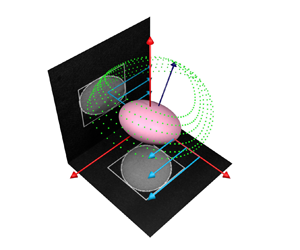Article contents
Influence of small inertia on Jeffery orbits
Published online by Cambridge University Press: 19 January 2024
Abstract

We experimentally investigate the rotational dynamics of neutrally buoyant axisymmetric particles in a simple shear flow. A custom-built shearing cell and a multi-view shape-reconstruction method are used to obtain direct measurements of the orientation and period of rotation of particles having oblate and prolate shapes (such as spheroids and cylinders) of varying aspect ratios. By systematically changing the viscosity of the fluid, we examine the effect of inertia (which may be originated from either phase) on the dynamical behaviour of these suspended particles up to a particle Reynolds number of approximately one. While no significant effect on the period of rotation is found in this small-inertia regime, a systematic drift among several rotations toward limiting stable orbits is observed. Prolate particles are seen to drift towards the tumbling orbit in the plane of shear, whereas oblate particles are driven either to the tumbling or to the vorticity-aligned spinning orbits, depending on their initial orientation. These results are compared with recent small-inertia asymptotic theories, assessing their range of validity, as well as to numerical simulations in the small-inertia regime for both prolate and oblate particles.
- Type
- JFM Papers
- Information
- Copyright
- © The Author(s), 2024. Published by Cambridge University Press
References
Di Giusto et al. supplementary movie 1
Di Giusto et al. supplementary movie 2
Di Giusto et al. supplementary movie 3
Di Giusto et al. supplementary movie 4
Di Giusto et al. supplementary movie 5
Di Giusto et al. supplementary movie 6
Di Giusto et al. supplementary movie 7
Di Giusto et al. supplementary movie 8
Di Giusto et al. supplementary movie 9
Di Giusto et al. supplementary movie 10
Di Giusto et al. supplementary movie 11
Di Giusto et al. supplementary movie 12
Di Giusto et al. supplementary movie 13
Di Giusto et al. supplementary movie 14
Di Giusto et al. supplementary movie 15
Di Giusto et al. supplementary movie 16
Di Giusto et al. supplementary movie 17
Di Giusto et al. supplementary movie 18
- 6
- Cited by



